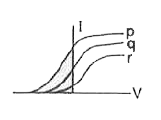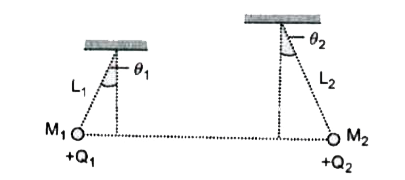Photoelectric effect experiments are performed using three different metal plates p, and r having work functions ϕP=2.0eV,ϕq=2.5eV and wavelengths of 550 nm, 450 nm and 350 nm with equal intensities illuminates each of the plates. The correct I-V graph for the experiment is (Take hc = 1240 eV nm)Solution in Kannada




The correct Answer is:A
The produce photoelectrons, the enrgy of the light incident hsould be greater than the work function of the wavelength of light incident should be shorter than the wavelength corresponding to the energy or the work function.
Wavelength less than λmax alone will cause photelectrons to be ejected λm=hcϕ
For ϕp,λmp=1240eVnm2.5eV=496nm
For ϕr,λmr=1240eVnm3eV=413.3nm
Wavelngths in the incident beam are 550 nm, 450 nm and 350 nm.
350 nm waves can generate photoelectrons from p,q and r.
450 nm is shorter than λm for p and q only and 550 nm < 620 nm only in this group. so it can excite on p-cell.
Currept ∝ intensity.
Intensity =Nhv of photoelectrons.
∴ I is maximum for p cell, one gets the maximum intensity, and next is for q cell and the r cell can give photelectrons only by 350 nm.
∴ I is minimum for r.
Topper's Solved these Questions
- BOOK - MODERN PUBLICATIONCHAPTER - ELECTRONS & PHOTONSEXERCISE - MULTIPLE CHOICE QUESTIONS (LEVEL-III)9videos
ELECTRONS & PHOTONS
- BOOK - MODERN PUBLICATIONCHAPTER - ELECTRONS & PHOTONSEXERCISE - RECENT COMPETITIVE QUESTIONS20videos
ELECTRONS & PHOTONS
- BOOK - MODERN PUBLICATIONCHAPTER - ELECTRONS & PHOTONSEXERCISE - RECENT COMPETITIVE QUESTIONS20videos
ELECTRONS & PHOTONS
- BOOK - MODERN PUBLICATIONCHAPTER - ELECTROMAGNETIC WAVESEXERCISE - RECENT COMPETITIVE QUESTIONS4videos
ELECTROMAGNETIC WAVES
- BOOK - MODERN PUBLICATIONCHAPTER - ELECTROSTATICSEXERCISE - RECENT COMPETITIVE QUESTIONS39videos
ELECTROSTATICS
Similar Questions
Energy required for the electron excitation in Li++ from the first to the third Bohr orbit is :
07:59View SolutionAccording to Einstein's photoelectric equation the graph of K.E. of the photoelectron emitted from the metal versus the frequency of the incident radiation gives a straight line graph whose slope
05:40View SolutionAccording to Einstein's photoelectric equation the graph of K.E. of the photoelectron emitted from the metal versus the frequency of the incident radiation gives a straight line graph whose slope
04:36View SolutionThe speed of electromagnetic wave in vacuum depends upon the source of radiation
03:51View SolutionTwo small spheres of masses M1andM2 are suspended by weightless insulating threads of lengths L1andL2 The spheres carry charges Q1andq2 respectively . The spheres are suspended such that they are in level with one another and the threads are inclined to the vertical at angles of θ1andθ2 as shown . Which one o fthe following conditions , if θ1=θ2 ?
 02:03View Solution
02:03View Solutionphotoelectric affect experiments are performer using ther different medal plates p,q andr having work functionphi_(p) = 2.0 eV, phi_(e) = 2.5 eVandphi_(r) = 3.0 eVrespectivelyAlightbeamconta∈∈gwave≤n>hof550nm , 450 nmand350nm withequal∫ensitiesilluminateseachoftheplate.Thecorrect1 -Vgraphfortheexperimentis [Take hc = 1240 eV nm]
02:09View SolutionThe figure below shows a vaccum tube containing electrodes made of different metals, 1 and 2 whose work functions are ϕ1 and ϕ2 The electrodes are illuminated simultaneously. The maximum kinetic energy of photoelectrons reaching plate 2 is 1 eV and maximum kinetic energy of photoelectrons reaching plate 1 is 3 eV. Assume that photoelectron emitted from either plate do not interact with each other ϕ1=1.5 eV and ϕ2=0.7 eV. Find wavelength (in nm) of the electromagnetic wave used
 06:48View Solution
06:48View SolutionIn a photoelectric experiment, the wavelength of the light incident on a metal is changed from 300 nm to 400 nm. Choose the closest value of change in the stopping potential from given options (hce=1240nm.V)
01:44View SolutionSurface of certain metal is first illuminated with light of wavelength λ1=350 nm and then, by light of wavelength λ2=540 nm. It is found that the maximum speed of the photo electrons in the two cases differ by a factor of 2. The work function of the metal (in eV) is close to :
(Energy of photon =1240λ(in nm)Ev02:58View Solutionएक धातु के पृष्ठ को 400 nm के प्रकाश से प्रदीप्त किया जाता है । उत्सर्जित प्रकाश-इलेक्ट्रॉनों की गतिज ऊर्जा 1.68 eV पायी जाती है । धातु का कार्य फलन है : (hc=1240 eV nm)
07:43View SolutionThe surface of a metal is illuminated with light of wavelength 400 nm. The kinetic energy of the ejected photoelectrons was found to be 1.68 eV. What is the work function of the metal ? [ hC=1240 eV*nm ]
07:43View SolutionPhotoelectric effect experiments are performed using three different metal plates p,q and r having work functions ϕp=2.0eV,andphi_q=2.5eV andphi_(tau) =3eV and wavelengths of 550 nm,550nm, and 350 nm with equal intensities , illuminates each of the plates . The correct I - V graph for the experiment is (Take hc = 1240 eV nm)
03:02View SolutionThe surface of a metal is illuminated with the light of 400 nm. The kinectic energy of the ejected photoelectrons was found to be 1.68 eV. The work function of the metal is (hc = 1240 eV nm)
03:08View SolutionThe surface of a metal is illuminated with the light of 400 nm. The kinetic energy of the ejected photoelectrons was found to be 1.68 eV. The work function of the metal is (hc = 1240 eV nm)
04:46View Solutionधातु की तीन भिन्न प्लेटों p,q व r,जिनके कार्य फलन क्रमशः ϕp=2.0eV,ϕq=2.5eV व ϕr=3.0eV है , को लेकर प्रकाश वैद्युत प्रभाव प्रयोग किए जाते हैं। तीनों प्रयोगों में एक प्रकाश पुंज का प्रयोग किया जाता है जो समान तीव्रता वाले 550 nm, 450 nm तथा 350 nm तरंगदैर्ध्य वाले प्रकाशों से मिलाकर बनाया गया है। इन तीनों के 1-V आरेख का सही चित्रण है( hc=1240eV लें)
03:50View Solution

